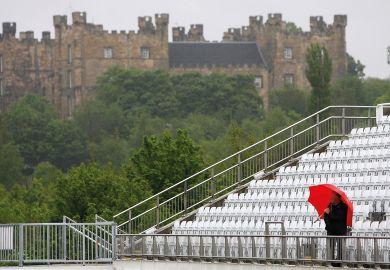Source: Corbis
A big step: the gap between the likelihood of the richest and the poorest entering an elite university did not change for 15 years
Elite universities are as socially exclusive as ever despite having spent hundreds of millions of pounds on bursaries and outreach activities since the 1990s, a report suggests.
According to a study by the Office for Fair Access, teenagers from the richest 20 per cent of families in England were 6.3 times more likely to enter one of the country’s most selective universities in 2011‑12 than those from the most disadvantaged 40 per cent of households – almost exactly the same level as it was in 1998 (6.4).
At one highly selective university, rich students were 16 times more likely to attend than poor students, while rich students were at least 10 times more likely to enrol at four other unnamed institutions, says the report, Trends in Young Participation by Student Background and Selectivity of Institution.
Overall, only 2.9 per cent of the poorest 40 per cent of 18-year-olds progressed to one of the 23 highest tariff universities in 2011-12 compared with 2.4 per cent in 1998.
It was teenagers from the affluent middle class who appeared to benefit most from the access initiatives, with 18.1 per cent of the richest fifth attending a high-tariff institution in 2011-12 compared with 15.4 per cent in the late 1990s.
However, the Russell Group of 24 research-intensive universities pointed out that the number of poor students attending high-tariff institutions has risen by about a quarter since 2011-12, a period not covered by the Offa analysis.
Almost all of the increase in higher education participation among poor students in the period studied came from institutions with low- or medium-level entry requirements, the report says.
Participation from the most disadvantaged 40 per cent of young people rose from 5.3 per cent to 8.5 per cent at low-entry-tariff universities between 1998-99 and 2011-12, while it rose from 4 per cent to 6.4 per cent at medium-tariff institutions.
The report could prove to be crucial evidence for those arguing for the Higher Education Funding Council for England to avoid cuts to its student opportunity fund for widening participation, which goes primarily to these low and mid-tariff institutions.
Hefce is expected to decide the level of any hit to the £332 million fund in the coming weeks after the government announced cuts totalling £125 million in this week’s annual grant letter.
Pam Tatlow, chief executive of Million+, which represents many post-1992 universities and has campaigned for the retention of the student opportunity fund, said these universities had not received enough credit for a “real success story”.
“If you are educating people from a range of backgrounds who are not as well prepared for higher education, it costs about a third more, which is why we have student opportunity funding,” Ms Tatlow said.
‘Less progress than desired’
Commenting on the report, Les Ebdon, the director of fair access, said that progress in recruiting more poor students had “not been spread evenly” across the sector.
“Highly selective institutions were not by 2011-12 making the progress we would like to have seen,” said Professor Ebdon, who took control of Offa in 2012.
He did say that the number of acceptances of disadvantaged 18-year-olds at highly selective institutions had risen by 26 per cent between 2011 and 2013, but “it was too soon to know if this marked the start of a long-term improvement”.
Wendy Piatt, director general of the Russell Group, also highlighted the upturn in acceptances, saying that universities in the group will spend more than £200 million on outreach activities and bursaries in the next year.
“We will keep working hard to tackle the access gap, but the main reason pupils from disadvantaged backgrounds are less likely to go to leading universities is because they are not achieving the right grades in the right subjects,” Dr Piatt said.
“It is also the case that some very bright students are not encouraged to apply for leading universities,” she added.
Register to continue
Why register?
- Registration is free and only takes a moment
- Once registered, you can read 3 articles a month
- Sign up for our newsletter
Subscribe
Or subscribe for unlimited access to:
- Unlimited access to news, views, insights & reviews
- Digital editions
- Digital access to THE’s university and college rankings analysis
Already registered or a current subscriber? Login





